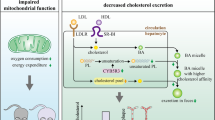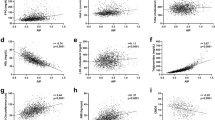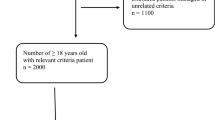Abstract
An atherogenic dyslipidemia, characterized by increased plasma triglyceride and apolipoprotein (apo) B levels, low HDL-cholesterol concentrations and the development of small, dense LDL particles has been associated with the presence of abdominal-visceral obesity. Visceral obesity is also associated with a hypercoagulate state and elevated concentrations of procoagulant factors such as factor VII. Moreover, it is known that some genetic variants in the gene encoding factor VII alter its activity and concentration, and consequently these variants may have an impact on atherosclerosis development. The objective of this study was to verify whether the factor VII R353Q polymorphism contributes to predict the risk of an atherogenic dyslipidemia in absence and in the presence of visceral obesity. A sample of 299 French-Canadian men, selected in order to cover a wide range of body fatness values, participated in this study. We observed that the R353 allele was more commonly observed among men characterized by apo B levels below 1.09 g/l than among men with apo B levels greater or above this threshold value (allele frequency of 92.1 vs 85.4%, χ2=6.18, P=0.01). Multivariate analyses further showed that the genotype R353/R353 was associated with a lower risk to exhibit atherogenic concentrations of total-apo B (≥1.09 g/l) and LDL apo B (≥0.95 g/l) before (odds ratio:0.47, 95%CI=0.27–0.90, P=0.02; odds ratio:0.46, 95%CI=0.25–0.85, P=0.01, respectively) and after adjustments for age and visceral AT (odds ratio:0.49, 95%CI=0.24–0.91, P=0.02; odds ratio:0.44, 95%CI=0.23-0.85, P=0.01, respectively). When the two genotype groups were further divided on the basis of visceral adipose tissue (AT) accumulation using a cutoff point of 130 cm2, we observed that R353/R353 homozygotes with low visceral AT were characterized by a more favorable lipoprotein-lipid profile, mainly lower total-cholesterol, total-apo B, and LDL-apo B levels compared with R353/R353 homozygotes with high levels of visceral AT. In contrast, irrespective of obesity, plasma lipid levels among carriers of the Q353 allele were similar to those of viscerally obese men homozygous for the R353 allele. In conclusion, results of the present study suggest that the factor VII R353 allele is associated with lower concentrations of plasma apo B levels. However, the presence of visceral obesity abolishes this effect. Further studies will be necessary to confirm this association and the mechanism involved.
Similar content being viewed by others
Log in or create a free account to read this content
Gain free access to this article, as well as selected content from this journal and more on nature.com
or
References
Avellone G, Di Garbo V, Cordova R, Cucinella G, De Simone R, Raneli G, Bompiani G (1994) Evaluation of cardiovascular risk factors in overweight and obese subjects. Int Angiol 13:25–29
Bavenholm P, Proudler A, Silveira A, Crook D, Blomback M, de Faire U, Hamsten A (1995) Relationships of insulin and intact and split proinsulin to haemostatic function in young men with and without coronary artery disease. Thromb Haemost 73:568–575
Carvalho de Sousa JC, Bruckert E, Giral P, Soria C, Chapman J, Truffert J, Dairou F, De Gennes JL, Caen JP (1989) Coagulation factor VII and plasma triglycerides. Decreased catabolism as a possible mechanism of factor VII hyperactivity. Haemostasis 19:125–130
Connelly PW, Poapst M, Davignon J, Lussier-Cacan S, Reeder B, Lessard R, Hegele RA, Csima A (1999) Reference values of plasma apolipoproteins A-I and B, and association with nonlipid risk factors in the populations of two Canadian provinces: Quebec and Saskatchewan. Canadian Heart Health Surveys Research Group. Can J Cardiol 15:409–418
de Maat MP, Green F, de Knijff P, Jespersen J, Kluft C (1997) Factor VII polymorphisms in populations with different risks of cardiovascular disease. Arterioscler Thromb Vasc Biol 17:1918–1923
de Sousa JC, Soria C, Ayrault-Jarrier M, Pastier D, Bruckert E, Amiral J, Bereziat G, Caen JP (1988) Association between coagulation factors VII and X with triglyceride rich lipoproteins. J Clin Pathol 41:940–944
Desbuquois B, Aurbach GD (1971) Use of polyethylene glycol to separate free and antibody-bound peptide hormones in radioimmunoassays. J Clin Endocrinol Metab 33:732–738
Després JP (1992) Abdominal obesity and the risk of coronary artery disease, Can J Cardiol 8:561–562
Després JP (1994) Dyslipidaemia and obesity. Baillieres Clin Endocrinol Metab 8:629–660
Després JP, Lamarche B (1993) Effects of diet and physical activity on adiposity and body fat distribution: Implications for the prevention of cardiovascular disease. Nutr Res Rev 6:137–159
Després JP, Nadeau A, Tremblay A, Ferland M, Moorjani S, Lupien P, Thériault G, Pinault S, Bouchard C (1989) Role of deep abdominal fat in the association between regional adipose tissue distribution and glucose tolerance in obese women. Diabetes 38:304–309
Després JP, Moorjani S, Lupien P, Tremblay A, Nadeau A, Bouchard C (1990) Regional distribution of body fat, plasma lipoproteins, and cardiovascular disease. Arteriosclerosis 10:497–511
Després JP, Prud'homme D, Pouliot MC, Tremblay A, Bouchard C (1991) Estimation of deep abdominal adipose-tissue accumulation from simple anthropometric measurements in men. Am J Clin Nutr 54:471–477
Després JP, Lamarche B, Mauriège P, Cantin B, Dagenais GR, Moorjani S, Lupien PJ, (1996) Hyperinsulinemia as an independent risk factor for ischemic heart disease. N Engl J Med 334:952–957
Ettelaie C, James NJ, Adam JM, Nicola KP, Wilbourn BR, Bruckdorfer KR (1998) Identification of a domain in apolipoprotein B-100 that inhibits the procoagulant activity of tissue factor. Biochem J 333:433–438
Ferland M, Després JP, Tremblay A, Pinault S, Nadeau A, Moorjani S, Lupien PJ, Thériault G, Bouchard C (1989) Assessment of adipose tissue distribution by computed axial tomography in obese women: association with body density and anthropometric measurements. Br J Nutr 61:139–148
Fuster V, Badimon L, Badimon JJ, Chesebro JH (1992) The pathogenesis of coronary artery disease and the acute coronary syndromes (1). N Engl J Med 326:242–250
Girelli D, Russo C, Ferraresi P, Olivieri O, Pinotti M, Friso S, Manzato F, Mazzucco A, Bernardi F, Corrocher R (2000) Polymorphisms in the factor VII gene and the risk of myocardial infarction in patients with coronary artery disease. N Engl J Med 343:774–780
Green F, Kelleher C, Wilkes H, Temple A, Meade T, Humphries S (1991) A common genetic polymorphism associated with lower coagulation factor VII levels in healthy individuals. Arterioscler Thromb 11:540–546
Hansen JB, Grimsgaard S, Huseby N, Sandset PM, Bonaa KH (2001) Serum lipids and regulation of tissue factor-induced coagulation in middle-aged men. Thromb Res 102:3–13
Heinrich J, Balleisen L, Schulte H, Assmann G, van de Loo J (1994) Fibrinogen and factor VII in the prediction of coronary risk. Results from the PROCAM study in healthy men. Arterioscler Thromb 14:54–59
Humphries SE, Green FR, Temple A, Dawson S, Henney A, Kelleher CH, Wilkes H, Meade TW, Wiman B, Hamsten A (1992) Genetic factors determining thrombosis and fibrinolysis. Ann Epidemiol 2: 371–385
Hunault M, Arbini AA, Lopaciuk S, Carew JA, Bauer KA (1997) The Arg353Gln polymorphism reduces the level of coagulation factor VII. In vivo and in vitro studies. Arterioscler Thromb Vasc Biol 17:2825–2829
Kjalke M, Silveira A, Hamsten A, Hedner U, Ezban M (2000) Plasma lipoproteins enhance tissue factor-independent factor VII activation. Arterioscler Thromb Vasc Biol 20:1835–1841
Lamarche B, Lemieux I, Despres JP (1999) The small, dense LDL phenotype and the risk of coronary heart disease: epidemiology, patho-physiology and therapeutic aspects. Diabetes Metab 25:199–211
Lane A, Cruickshank JK, Mitchell J, Henderson A, Humphries S, Green F (1992) Genetic and environmental determinants of factor VII coagulant activity in ethnic groups at differing risk of coronary heart disease. Atherosclerosis 94:43–50
Laurell CB (1966) Quantitative estimation of proteins by electrophoresis in agarose gel containing antibodies. Anal Biochem 15:42
Mansfield MW, Heywood DM, Grant PJ (1996) Circulating levels of factor VII, fibrinogen, von Willebrand factor and features of insulin resistance in first-degree relatives of patients with NIDDM. Circulation 94: 2171–2176
Meade TW, Mellows S, Brozovic M, Miller GJ, Chakrabarti RR, North WR, Haines AP, Stirling Y, Imeson JD, Thompson SG (1986) Haemostatic function and ischaemic heart disease: principal results of the Northwick Park Heart Study. Lancet 2:533–537
Miller GJ, Bauer KA, Barzegar S, Cooper JA, Rosenberg RD (1996) Increased activation of the haemostatic system in men at high risk of fatal coronary heart disease. Thromb Haemost 75:767–771
Moor E, Silveira A, van't Hooft F, Suontaka AM, Eriksson P, Blomback M, Hamsten A (1995) Coagulation factor VII mass and activity in young men with myocardial infarction at a young age. Role of plasma lipoproteins and factor VII genotype Arterioscler Thromb Vasc Biol 15:655–664
Moorjani S, Dupont A, Labrie F, Lupien PJ, Brun D, Gagné C, Giguère M, Bélanger A (1987) Increase in plasma high-density lipoprotein concentration following complete androgen blockage in men with prostatic carcinoma. Metabolism 36:244–250
Pankow JS, Folsom AR, Shahar E, Tsai MY, Jeffery RW, Wing RR (1998) Weight-loss induced changes in plasma factor VII coagulant activity and relation to the factor VII Arg/Gln353 polymorphism in moderately obese adults. Thromb Haemost 79:784–789
Peiris AN, Sothmann MS, Hoffmann RG, Hennes MI, Wilson CR, Gustafson AB, Kissebah AH (1989) Adiposity, fat distribution, and cardiovascular risk. Ann Intern Med 110:867–872
Pouliot MC, Després JP, Nadeau A, Moorjani S, Prud'homme D, Lupien PJ, Tremblay A, Bouchard C (1992) Visceral obesity in men. Associations with glucose tolerance, plasma insulin, and lipoprotein levels. Diabetes 41:826–834
Rao LV, Rapaport SI (1988) Activation of factor VII bound to tissue factor: a key early step in the tissue factor pathway of blood coagulation. Proc Natl Acad Sci USA 85:6687–6691
Richterich R, Dauwalder H (1971) Zur bestimmung der plasmaglukosekonzentration mit der hexokinase-glucose-6-phosphat-dehydrogenase-method. Schweiz Med Wochenschr 101:615–618
Saha N, Liu Y, Heng CK, Hong S, Low PS, Tay JS (1994) Association of factor VII genotype with plasma factor VII activity and antigen levels in healthy Indian adults and interaction with triglycerides. Arterioscler Thromb 14:1923–1927
Silveira A, Karpe F, Blomback M, Steiner G, Walldius G, Hamsten A (1994) Activation of coagulation factor VII during alimentary lipemia. Arterioscler Thromb 14:60–69
Stengard JH, Salomaa V, Rasi V, Vahtera E, Ehnholm C, Krusius T, Perola M, Vartiainen E (2001) Utility of the Arg/Gln polymorphism of the factor VII (FVII) gene, serum lipid levels and body mass index in the prediction of the FVII:C and FVII:Ag in North Karelia; a cross-sectional and prospective study. Blood Coagul Fibrinolysis 12:445–452
Vaisanen S, Rankinen T, Penttila I, Rauramaa R (1995) Factor VII coagulant activity in relation to serum lipoproteins and dietary fat in middle-aged men. Thromb Haemost 73:435–438
Vambergue A, Rugeri L, Gaveriaux V, Devos P, Martin A, Fermon C, Fontaine B, Jude B (2001) Factor VII, tissue factor pathway inhibitor, and monocyte tissue factor in diabetes mellitus: influence of type of diabetes, obesity index, and age. Thromb Res 101:367–375
Van der kooy K, Seidell JC (1993) Techniques for the measurement of visceral fat: a practical guide. Int J Obes Relat Metab Disord 17:187–196
Vergnani L, Zuliani G, Ricci F, Manzoli N, Carantoni M, Volpato S, Fellin R (1998) Fibrinolytic and coagulation factors in very old subjects: association with lipoprotein profile and anthropometric variables. J Gerontol A Biol Sci Med Sci 53:M8–13
Welty FK, Mittleman MA, Wilson PW, Sutherland PA, Matheney TH, Lipinska I, Muller JE, Levy D, Tofler GH (1997) Hypobetalipoproteinemia is associated with low levels of hemostatic risk factors in the Framingham offspring population. Circulation 95:825–830
Wu AH, Tsongalis GJ (2001) Correlation of polymorphisms to coagulation and biochemical risk factors for cardiovascular diseases. Am J Cardiol 87:1361–1366
Acknowledgements
We are indebted to the subjects involved in this study. Marie-Claude Vohl is recipient of a scholarship from the Fonds de la Recherche en Santé du Québec (FRSQ). Jean Bergeron is a clinical scholar from the FRSQ. Jean-Pierre Després is chair professor of human nutrition, lipidology and prevention of cardiovascular disease supported by Pfizer Canada and Provigo. Part of this work was supported by the Canadian Institutes for Health Research (operating grant: MOP 44074) and the Heart and Stroke Foundation of Canada.
Author information
Authors and Affiliations
Corresponding author
Rights and permissions
About this article
Cite this article
Berthier, MT., Houde, A., Bergeron, J. et al. Effect of the factor VII R353Q missense mutation on plasma apolipoprotein B levels: impact of visceral obesity. J Hum Genet 48, 367–373 (2003). https://doi.org/10.1007/s10038-003-0039-x
Received:
Accepted:
Published:
Issue date:
DOI: https://doi.org/10.1007/s10038-003-0039-x
Keywords
This article is cited by
-
Humans, Mice, and Mechanisms of Intestinal Atresias: A Window into Understanding Early Intestinal Development
Journal of Gastrointestinal Surgery (2011)



